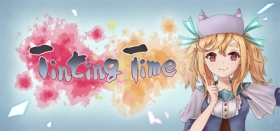
Tinting Time Review
There is a special place in my heart for the humble indie developers, especially when they work to release something on their own. The indie market has some of the most interesting game ideas, but it is also the easiest place for first-time developers to trip up as well. One of the hardest lessons to learn is that an interesting mechanic is not all a game needs. This is where we find Tinting Time, the first game of developer and publisher MrBamBam, and it is clearly a labour of love for the crafting style RPG.
The game comes with two distinct modes: the story mode and the roguelike mode. If you select the story mode, then you play as Tataku, a creator. Her job, and the job of all creators, is to use a mix of elements and minerals to…well, create compounds for people around the world (basically, they are alchemists). The plot of the main game focuses on two months of Tataku’s life and her new roommate, Avril, or Vril. Honestly, the plot is nothing amazing, and the world is generic but it does its job and keeps the game moving along. However, Tinting Time is hampered by one major issue: the translation of the game is completely broken. The grammar, punctuation (and even some of the words) do not always make sense. For all intents and purposes, it feels as though the game's script has been fed through Google Translate. This may not seem like the worst thing, but it takes away from the plot and makes reading a text-heavy game almost unbearable.

The main focus of Tinting Time is creating the potions and materials that the town folk ask for. This is done on the creator bench and revolves around using the correct elements in groups of three to make crystals, which can then be turned into mineral salts. It is up to the player to use the correct elements to add certain aspects to reach the desired qualities for the customer. For instance, you may be asked to make glue that is sticky and viscous. To make the glue, you need to use the recipe and make sure you use the right amount of water elements. The reason for this is that you need to sacrifice water elements to select the viscous and sticky qualities once the glue is made. This adds a certain amount of challenge to the creation, turning it into a mini puzzle. However, the menu is a bit fiddly, and it can be hard to understand exactly how much of each element is needed to make the final changes.
Tinting Time also offers upgrades and a mood system that can change how the crafting bench works and how each creation comes out. There are also several different types of quests, and each of the characters usually has something to offer the player for completing their tasks. This all has to be done with a stamina metre of sorts and an exhaustion system for the creating table. It is a fair amount to juggle, but it is streamlined enough to make it bearable.

Visually, Tinting Time is interesting and very anime in its style. The world is shown in a Chibi art style, with the characters each standing in designated spots. However, when talking to the characters, they take on a more detailed anime style, and the art is by no means bad. Honestly, the fact that a single person made this is impressive, and the art reflects a fair amount of care. Sadly, the music can grate on the ears after a while, and there isn’t a lot of variation. However, with no voice actors, you could just turn it off and have something playing in the background.
I wish that I could comment fully on the other mode where you play as Nuby and run her café. The mode is not yet complete but will be in a later update. However, the small amount that I did play involved making coffee for customers, and it seems like it will be the main focus of the post-game.
Tinting Time (Reviewed on Windows)
Minor enjoyable interactions, but on the whole is underwhelming.
Tinting Time has an interesting crafting system and art style. However, the translation issues make it very difficult to play through and lessen the overall experience.






COMMENTS